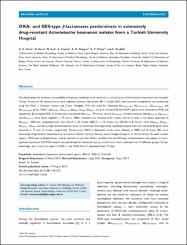OXA- and GES-type beta-lactamases predominate in extensively drug-resistant Acinetobacter baumannii isolates from a Turkish University Hospital

View/
Access
info:eu-repo/semantics/openAccessDate
2014Author
Çiçek, Ayşegül ÇopurSaral, Ayşegül
Iraz, Meryem
Ceylan, Ayşenur
Düzgün, Azer Özad
Peleg, Anton Y.
Sandallı, Cemal
Metadata
Show full item recordCitation
Cicek, A.C., Saral, A:, Iraz, M., Ceylan, A., Duzgun, A.O., Peleg, A.Y., Sandalli, C., (2014).OXA- and GES-type beta-lactamases predominate in extensively drug-resistant Acinetobacter baumannii isolates from a Turkish University Hospital.Clinical Microbiology and Infection, 20(5), 410-415.https://doi.org/10.1111/1469-0691.12338Abstract
We determined the antibiotic susceptibility and genetic mechanisms of resistance in clinical strains of Acinetobacter baumannii from Istanbul, Turkey. A total of 101 clinical strains were collected between November 2011 and July 2012. Antimicrobial susceptibility was performed using the Vitek 2 Compact system and E-test. Multiplex PCR was used for detecting bla(OXA-51-like), bla(OXA-23-like), bla(OXA-40-like) and bla(OXA-58-like) genes. ISAba1, bla(IMP-like), bla(VIM-like), bla(GES), bla(VEB), bla(PER-2), aac-3-Ia and aac-6'-Ib and NDM-1 genes were detected by PCR and sequencing. By multiplex PCR, all strains were positive for bla(OXA-51), 79 strains carried bla(OXA-23) and one strain carried bla(OXA-40). bla(OXA-51) and bla(OXA-23) were found together in 79 strains. ISAba1 element was detected in 81 strains, and in all cases it was found upstream of bla(OXA-51). GES-type carbapenemases were found in 24 strains (GES-11 in 16 strains and GES-22 in 8 strains) while bla(PER-2), bla(VEB-1), bla(NDM-1), bla(IMP)- and bla(VIM)-type carbapenemases were not observed. Aminoglycoside modifying enzyme (aac-3-Ia and aac-6'Ib) genes were detected in 13 and 15 strains, respectively. Ninety-seven (96%) A. baumannii strains were defined as MDR and of these, 98% were extensively drug resistant (sensitive only to colistin). Colistin remains the only active compound against all clinical strains. As seen in other regions, OXA-type carbapenemases, with or without an upstream ISAba1, predominate but GES-type carbapenemases also appear to have a significant presence. REP-PCR analysis was performed for molecular typing and all strains were collected into 12 different groups. To our knowledge, this is the first report of GES-11 and OXA-40 in A. baumannii from Turkey.

















